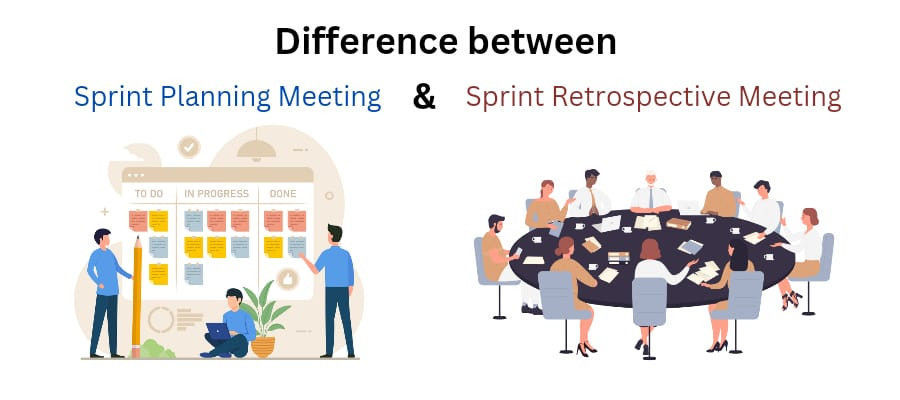Difference between Sprint Planning Meeting and Sprint Retrospective Meeting?

In Agile product management, particularly within the Scrum framework, the terms "Sprint planning meeting" and "Sprint retrospective meeting" may appear similar or interchangeable. However, it is essential to recognize the significant differences between these two crucial components of the Scrum process. Even experienced Scrum Teams can sometimes confuse or overlook these distinctions, leading to suboptimal outcomes.
In this blog post, we will delve into the dissimilarities between Sprint planning and Sprint retrospective meetings, shedding light on their distinct purposes and how they contribute to the success of Agile projects. By grasping these meetings' unique roles and functions, teams can leverage them effectively, enhancing collaboration, learning, and overall project outcomes.
What is Sprint Planning Meeting?
Sprint planning is an important event within the Scrum framework that serves as the launch pad for each Sprint. Its primary objective is to clearly understand what can be accomplished during the Sprint and how the work will be executed. This collaborative session involves the entire Scrum Team.
In Scrum, the concept of Sprinting goes beyond its athletic counterpart. It entails continuously delivering functioning software while fostering a perpetual learning and improvement culture.
During Sprint planning, the team sets the foundation for the upcoming Sprint. This includes determining the duration of the time-boxed Sprint, defining the Sprint goal, and identifying the starting point for the work. The session sets the agenda and focuses, providing a structured framework for the team's activities. When conducted effectively, Sprint planning instills motivation, encourages challenges, and creates an environment conducive to the team's success.
When is a Sprint Planning Meeting Held?
A Sprint Planning meeting is typically scheduled every two weeks in the Scrum framework. However, the frequency of these meetings can be adjusted based on the specific needs and preferences of each Scrum Team. Depending on the project's requirements, a Sprint Planning meeting can be conducted every one to four weeks.
It is essential to approach Sprint Planning meetings as time-boxed sessions, meaning a specific time limit should be set for each meeting. For instance, if a Sprint lasts one week, the Sprint Planning meeting should ideally be completed within two hours. Similarly, for a two-week Sprint, the meeting should be limited to a maximum of four hours, and so on.
What is Sprint Retrospective Meeting?
After a Sprint, a project management technique involving completing specific tasks within a designated timeframe, teams gather for a Sprint retrospective meeting. This meeting serves as a platform to review the successes and areas for improvement from the previous Sprint cycle, essentially discussing what actions should be initiated, ceased, or continued.
An integral component of the Scrum framework, which has been employed since the early 1990s to develop various projects, including software, hardware, embedded software, networks, and autonomous vehicles, the Agile Sprint retrospective is crucial in achieving continuous, iterative enhancement. It offers an official opportunity for teams to reflect upon their practices and refine them, following the conclusion of a Sprint and adhering to predetermined, regular intervals.
When is a Sprint Planning Meeting Held?
The Sprint retrospective is a time-constrained meeting in the Scrum framework that occurs after the Sprint review and before Sprint planning. Its primary purpose is as follows:
Evaluate the recent Sprint: The retrospective examines the people, relationships, processes, and tools of the just-completed Sprint. It aims to assess both the positive and negative aspects of the Sprint.
- Identify successes and areas for improvement: The retrospective allows for identifying and prioritizing successful elements and aspects that need improvement from the previous Sprint.
- Propose improvements: Based on the identified areas for improvement, the retrospective aims to generate a plan for implementing changes to enhance the Scrum team's work practices.
Critical Differences Between Sprint Planning Meeting and Sprint Retrospective Meeting
Timing and Sequence: The Sprint Planning Meeting takes place at the beginning of the Sprint, serving as the initial step to define the Sprint goal and plan the work to be undertaken. On the other hand, the Sprint Retrospective Meeting occurs at the end of the Sprint cycle, after the Sprint review, and before the next Sprint Planning Meeting.
Focus and Objective: The Sprint Planning Meeting sets the direction and scope for the upcoming Sprint. On the other hand, the Sprint Retrospective Meeting concentrates on reviewing the just-completed Sprint and identifying both successful and problematic areas.
Participants: The Sprint Planning Meeting involves the entire Scrum Team, including the product owner, Scrum Master, and development team members. The Sprint Retrospective Meeting also affects the whole Scrum Team, allowing everyone to reflect on the Sprint and contribute to the discussion on improvements.
Outlook: The Sprint Planning Meeting is future-oriented, focusing on planning and setting goals for the upcoming Sprint. On the other hand, the Sprint Retrospective Meeting is retrospective, looking back at the completed Sprint to assess what went well, what didn't, and how to improve in the future.
Wrapping up
Understanding these differences is crucial for Scrum Teams to utilize both meetings to their advantage effectively. The Sprint Planning Meeting sets the groundwork for a successful Sprint, while the Sprint Retrospective Meeting promotes continuous improvement and adaptation in future Sprints.
Reference
- https://business.adobe.com/blog/basics/Sprint-retrospective
- https://blog.adam.ai/Sprint-planning-meeting-and-Sprint-planning-agenda-template



